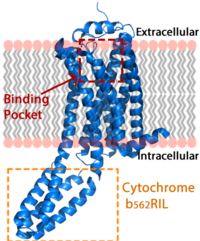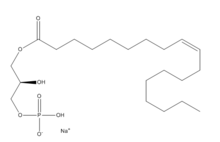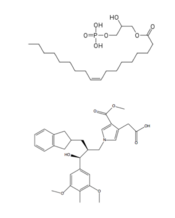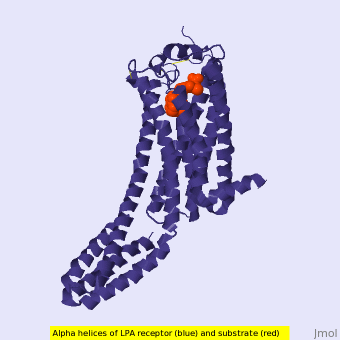Lysophosphatidic acid receptor
From Proteopedia
This page, as it appeared on June 14, 2016, was featured in this article in the journal Biochemistry and Molecular Biology Education.
Lysophosphatidic Acid Receptor 1
IntroductionLysophosphatidic Acid Receptor 1 (commonly referred to as LPA1) is a G protein-coupled receptor and one of 6 different LPA receptors (LPA1-LPA6). These receptors bind the phospholipid derivative lysophosphatidic acid (LPA), a signaling molecule that acts as a potent mitogen upon binding to one of its six receptors.[1] LPA1 is part of the larger EDG receptor family, which includes the more widely studied sphingosine 1-phosphate receptors.[1] LPA1 is responsible for initiating several different signaling cascades with different molecules and G-proteins.[2] These cascades ultimately result in growth, survival, and movement of cells, as well as neural cell development.[3] See also Lysophosphatidic AcidLysophosphatidic Acid (LPA) consists of an unsaturated fatty acid chain, a glycerol backbone, and a free phosphate group (Figure 2). Lysophosphatidic acid is found in nearly all cells, tissues, and fluids of the body.[1] LPA is present intracellularly as a precursor of phospholipid biosynthesis, and extracellularly as a signalling phospholipid.Extracellularly, LPA is produced from lysophosphatidylcholine by the enzyme autotaxin.[1] Autotaxin was originally linked with metastasis, and this link was later discovered to be mediated through the production of LPA, which signals cell proliferation.[4] All of LPA’s activities are receptor mediated; the signalling lipid interacts with at least six G-protein coupled receptors LPA1-LPA6.
StructureThe LPA1 receptor protein is composed of 364 amino acids with a molecular weight of approximately 41 kDa. Common to all G-protein coupled receptors, LPA1 contains seven alpha helices which make up the seven transmembrane spanning domains with three intracellular loops and three extracellular loops.[5] Within these helices is an interior binding pocket that stabilizes the binding of LPA1's natural ligand, LPA (Figure 1). The opening to this binding pocket is larger than other LPA receptors, enabling this receptor to bind ligands other than its natural ligand, such as 2-AG.[1] LPA1 lies in the membrane as shown in Figure 1, and as shown by the fatty acid bound in the crystallization of LPA1 in orange. Most polar amino acids (red) reside on the intracellular and extracellular areas of the receptor, while most residues positioned on the trans membrane helices inside the membrane are hydrophobic (blue). A cytochrome b (b562RIL) protein was inserted into the third intracellular loop to facilitate crystallization (Figure 2).[1] The intracellular region of this membrane protein is coupled to a heterotrimeric G protein. Structural StabilizationThree native disulfide bonds in the extracellular region of this receptor provide fold stability.[1] The first disulfide bond constrains the N terminal helix to extracellular loop (ECL) 2. The second disulfide bond shapes ECL2, and the third binds ECL3 to one of the transmembrane alpha helices. These disulfide bonds provide intramolecular stabilization along the extracellular region of the LPA1 receptor, where the substrate enters into the binding pocket. The N-terminus is a six turn alpha helix and functions like a cap on the extracellular side of the protein, packing tightly against ECL1 and ECL2.[1] The N-terminus helix also provides polar amino acids that interact with the ligand when bound. The extracellular region of this receptor plays a role in substrate specificity. Key Ligand Interactions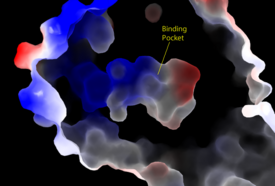 Figure 3: Electrostatic illustration of the amphipathic binding pocket of the LPA1 receptor. This binding pocket was revealed by cutting away the exterior or the protein. This binding pocket, located in the interior of the protein, has both polar and nonpolar regions. The blue and red coloration highlight the positively and negatively charged regions, respectively, and the white color shows the nonpolar region of the binding pocket. ONO-9780307 (ON7) is an antagonist for LPA due to its large nonpolar region, chiral hydroxyl group, ester, and carboxylic acid which all resemble portions of the LPA molecule (Figure 4). Four separate interactions with this antagonist of LPA1 help demonstrate the key interactions that stabilize the binding of the LPA phospholipid to this receptor. In the nonpolar region of the binding pocket, three non polar residues of LPA1 stabilize the large nonpolar group of ON7. At the polar region, the ligand binding is stabilized by Arg124 and Glu125 forming ionic and polar interactions with the carboxylic acid and the hydroxyl group of ON7.[1] In addition, interplay between Glu293 and Lys39 causes another stabilizing component with the ON7 antagonist. Glu293 forms polar interactions with Lys39, positioning it in close proximity to to the carboxylic acid of ON7, which then interactions with Lys39 via ionic bonding.[1] While Lys39 is highly conserved among all six LPA receptors, a neighboring histidine residue is specific to the LPA1 receptor. His40 forms both ionic and polar interactions with the carboxylic acid of ON7. Protonation of this residue greatly affects the binding affinity of LPA, leading to an increase in the pathways associated with cell proliferation and migration. Because cancerous tumors create acidic environments where His40 is protonated, this residue is an important link to tumor growth and cancer cell movement.[1] FunctionThe LPA1 receptor is present in nearly all cells and tissues, and deletion of the LPA1 receptor has physiological effects on every organ system, indicating its wide range of functions. Specifically, this receptor initiates downstream signaling cascades with three Gα proteins: Gi/o, Gq/11, and G12/13. Specifically, Gα proteins begin signaling cascades that activate phospholipase C and MAPKs that signal for cell proliferation, survival, and migration. [2] Despite this receptor being expressed ubiquitously, LPA1 is highly expressed in neural tissue, aiding in several different neurodevelopmental processes including growth and folding of the cerebral cortex and the growth, survival, and migration of neural progenitor cells.[3] Finally, LPA1 receptors expressed in neural tissue act through a signaling pathway with the Rac1 G-protein to aid in Schwann cell migration and myelination.[6] Receptor ComparisonSphingosine 1-Phosphate ReceptorLysophosphatidic Acid Receptors (LPA) are part of a larger family known as lysophospholipid receptor family (EDG family), including the archetype sphingosine-1-phosphate receptors (S1P1). The only structure previously reported in this GPCR family was of S1P1, and it provides a comparison for the differential structure and function to LPA1.[1] A major difference was observed in ligand access between these two receptors. The binding path in LPA1 is located in the extracellular milieu, while in S1P1 the ligand accesses the binding pocket through the membrane (Figure 1). The overall shape of each binding pocket is also different, as the S1P1 binding pocket has more of an oval shape, whereas the LPA1 binding pocket has a more spherical shape (Figure 5). The more spherical binding pocket for LPA1 also gives it the ability to recognize a larger group of chemical species. In particular, LPA1 has the ability to bind with ligands that have acyl chains of varying lengths.[1] Since LPA1 binds with a variety of acyl chains, it is used in multiple pathways.
Structural evidence for this altered ligand binding pathway includes global changes in the positioning of the extracellular loops (ECL) and transmembrane helices (TM). Specifically, a slight divergence of TMI, which is positioned 3 Å closer to TMVII compared to S1P1, and a repositioning of ECL3, resulting in a divergence of 8 Å from S1P1 result in ligand access via the extracellular space. [1] This narrowing of the gap between TMI and TMVII blocks membrane ligand access in LPA1, while the greater distance between ECL3 and the other extracellular loops promotes extracellular access for LPA1. Additionally, ECL0 is helical in S1P1, but lacks secondary structure in LPA1. This increased flexibility that results from ECL0 lack of secondary structure in LPA1 further promotes favorable LPA access to the binding pocket from the extracellular space. [1] Endocannabinoid Receptor 1LPA1 is also closely related to the first of the six cannabinoid receptors. This close relation gives CB1 (Cannabinoid Receptor 1) the ability to bind to analogs of LPA and LPA1 the ability to bind to analogs of CB1 ligands. [1] This crossing over of ligand binding opens the possibility of metabolic crosstalk between the two signaling systems. [1] Complementary access to the LPA1 binding pocket can be achieved by phosphorylated CB1 ligand analogs, while complementary access to the CB1 binding site requires dephosphorylation of LPA1 ligand analogs. In both cases, a ligand could serve as a primary receptor modulator and a simultaneous prodrug for a different receptor. [1] A major cannabinoid signaling molecule, 2-arachidonyl glycerol (2-AG, Figure 6), can be phosphorylated into 2-arachidonyl phosphatidic acid (2-ALPA). 2-ALPA has a similar structure to LPA, and is able to bind in the LPA1 receptor binding pocket. 2-ALPA binding to LPA1 causes the same downstream signaling that the LPA molecule does, effectively connecting these two systems. Promiscuous ligand binding between these two pathways has potential functional and therapeutic implications.[1]Residues Asp129 and Trp210 located within the hydrophobic binding pocket of LPA1 may share responsibility for the preference for long unsaturated acyl chains, including the ligand LPA. The polarity of these residues provide favorable interactions between the ligand and the binding pocket.[1] Additionally, Asp129 and Trp210 may serve as a trigger for agonist induced conformational changes. These residues are also interesting in regard to GPCR phylogenic evolution. [1] Trp210 in the binding pocket of LPA1 is unique to the lysophospholipid and cannabinoid receptors, suggesting that they are related. A model for lipid agonist binding generated through molecular modeling was used to dock two of the cannabinoid receptor CB1's most abundant endogenous ligands into the LPA1 binding pocket. [1] Rotameric shifts of Trp210 and Trp271 lead to the expansion of the binding pocket and the exposure of the π clouds of their indole rings. These shifts and expansion provided favorable interactions with the double bonds of the phosphorylated cannabinoid ligands. This favorable binding provided evidence that the hydrophobic binding pockets of LPA1 and CB1 are able to favorably bind the same poly-unsaturated acyl chains with metabolically interconvertible head groups.[1] Disease RelevanceBecause LPA1 is expressed in so many tissues throughout the body, LPA1 has been linked to the symptoms and progression of several different diseases and disorders.[7][8] CancerMany of the functions of LPA1, i.e. cell proliferation, survival, and morphology, are implicated in cancers. LPA acts as a tumor mitogen and an inducer of tumor-derived cytokine to support the metastasis (spreading) of breast and ovarian cancer to bones. Inhibition of LPA1 can significantly reduce this progression, and therefore may be a promising treatment for patients with bone metastasis. [9] LPA does not have an effect on primary tumor size. [10] Part of this tumorigenesis can be explained by the action of His40 on LPA1 where, when protonated His40 increases LPA binding affinity by up to 1kcal/mol.[1] Consequently, in the acidic environment produced by hypoxic tumors, LPA1 activity is increased, allowing these tumors to continue to proliferate, migrate, and survive.[8] PainWhen an injury occurs, LPA is released in the body. LPA will then activate G-protein-coupled receptors. Within the nervous system, LPA plays a role in the nociceptive process (nociceptive pain is a sharp pain that can come from a mild burn or twisted ankle). The LPA signaling will activate GTPase RhoA [11]. Once activated Rho translocates to the plasma membrane. Rho will activate Rho kinase (ROCK) [11]. The activation of ROCK is a required step in the pathway in the stimulation of neurotic pain. When ROCK was inhibited the remaining pathway no longer functioned normally. Mice with the deletion of LPA1 receptors had lower levels of pain [11]. FibrosisIdiopathic pulmonary fibrosis (IPF) has high rates of mortality [12]. Understanding how LPA can effect fibrosis, is an important factor to finding medication and a cure for this disease. The pathway of LPA-LPA1 is important in mediating fibroblast migration and Wound Healing. Once fibrosis has been contracted LPA levels increase in the bronchoalveolar lavage (BAL) fluid. The study showed that mice lacking LPA1 had protection from mortality and were able to survive fibrosis. LPA1 plays an active role between lung injury and contracting pulmonary fibrosis. The absence of LPA results in a vascular leak after an initial injury, leading to fibrosis. LPA1 is a link between lung injury and pulmonary fibrosis [12]. 3D structures of lysophosphatidic acid receptorUpdated on 19-June-2023 4z34, 4z35, 4z36 - hLPA1 + antagonist - human 2lq4 – hLPA1 second extracellular loop – NMR References
Proteopedia ResourcesCategory:Lysophosphatidic acid binding Category:Lysophosphatidic acid Butler University Proteopedia Pages See also: | ||||||
Student Contributors
Heather Hansen
Stephanie Kuhlman
Chandler Mitchell
Clayton Taylor
Proteopedia Page Contributors and Editors (what is this?)
Michal Harel, Alexander Berchansky, Angel Herraez, Joel L. Sussman, R. Jeremy Johnson
